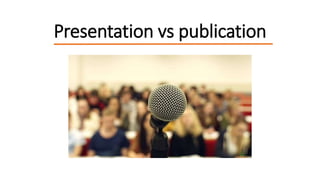Presentation vs Publication
•Télécharger en tant que PPTX, PDF•
1 j'aime•227 vues
Presentation by Chris O'Brien, of the Food and Agricultural Organization of the United Nations (Bay of Bengal LME project) during the science to communication workshop in the 8th GEF Biennial International Waters Conference.
Signaler
Partager
Signaler
Partager

Recommandé
Payments for Ecosystem Services in the Cotswold Catchment

Payments for Ecosystem Services in the Cotswold CatchmentCountryside and Community Research Institute
Introduction to Payment for Ecosystem Services (Chris Short)

Introduction to Payment for Ecosystem Services (Chris Short)Countryside and Community Research Institute
Recommandé
Payments for Ecosystem Services in the Cotswold Catchment

Payments for Ecosystem Services in the Cotswold CatchmentCountryside and Community Research Institute
Introduction to Payment for Ecosystem Services (Chris Short)

Introduction to Payment for Ecosystem Services (Chris Short)Countryside and Community Research Institute
Contenu connexe
Plus de Iwl Pcu
Plus de Iwl Pcu (20)
Caribbean Wastewater - Innovative Solutions (IWC8)

Caribbean Wastewater - Innovative Solutions (IWC8)
Large Marine Ecosystems: Megaregional Best Practices for LME Assessment and M...

Large Marine Ecosystems: Megaregional Best Practices for LME Assessment and M...
How to communicate science effectively (IWC8 Presentation)

How to communicate science effectively (IWC8 Presentation)
GEF Oceanic Fisheries Management Project – Towards Transformation Change (IWC...

GEF Oceanic Fisheries Management Project – Towards Transformation Change (IWC...
TDA/SAP Methodology Training Course Module 2 Section 1

TDA/SAP Methodology Training Course Module 2 Section 1
TDA/SAP Methodology Training Course Module 2 Section 10

TDA/SAP Methodology Training Course Module 2 Section 10
TDA/SAP Methodology Training Course Module 2 Section 10

TDA/SAP Methodology Training Course Module 2 Section 10
TDA/SAP Methodology Training Course Module 2 Section 9

TDA/SAP Methodology Training Course Module 2 Section 9
TDA/SAP Methodology Training Course Module 2 Section 5

TDA/SAP Methodology Training Course Module 2 Section 5
TDA/SAP Methodology Training Course Module 2 Section 5

TDA/SAP Methodology Training Course Module 2 Section 5
TDA/SAP Methodology Training Course Module 2 Section 5

TDA/SAP Methodology Training Course Module 2 Section 5
TDA/SAP Methodology Training Course Module 2 Section 7

TDA/SAP Methodology Training Course Module 2 Section 7
TDA/SAP Methodology Training Course Module 2 Section 5

TDA/SAP Methodology Training Course Module 2 Section 5
TDA/SAP Methodology Training Course Module 2 Section 6

TDA/SAP Methodology Training Course Module 2 Section 6
TDA/SAP Methodology Training Course Module 2 Section 5

TDA/SAP Methodology Training Course Module 2 Section 5
TDA/SAP Methodology Training Course Module 2 Section 4

TDA/SAP Methodology Training Course Module 2 Section 4
Presentation vs Publication
- 2. Publication vs. Presentation Publication • Audience – narrow/expert • Read (passive voice) • Sentences, paragraphs • Time – lots (hours) • Distance – arm’s length • Detail [ ] Introduction Methods Results Tables & Figures • Discussion & Conclusions Presentation • Audience – broader • Listen (active voice) • Phrases, dot points • Time – little (4 sec) • Distance – metres to vast • Broad brush [ ] Need Approach Supporting evidence Conclusion • Take home message
- 3. Setting the stage Message Audience What’s your point? How you engage Why does it matter? Impact !
- 4. Message • What’s your story? • How much time do you have? • How much detail can you give?
- 5. Action time
Notes de l'éditeur
- Why text, graphs and tables don’t translate easily from pub to talk: Narrow (specialist) vs broad and variable audience You want people to listen to presentation not read Concepts and conclusions in a paragraph become a dot point Time is very precious in talk and slides need to be understood in ≤4 sec Slides need to be visible at great distances not arm’s length Detail needs to be simplified – listener can’t go back to get it Structure of paper and presentation very different – in talk you stress the need and the conclusion with very few or no methods and limited detail of findings
- 3
- 4
- Ok, now it is action time again . Can you see the 3 bus stops Run and stand as bus is about to start. Once you are there. I will tell you what's next…. Ok welcome to bus stop. In each bus stop you see a question As a group discuss and in point provide many bullet point answers as possible You have 3 minutes Ok now move clock wise and add more points in the next bus stop Whistle blows again
